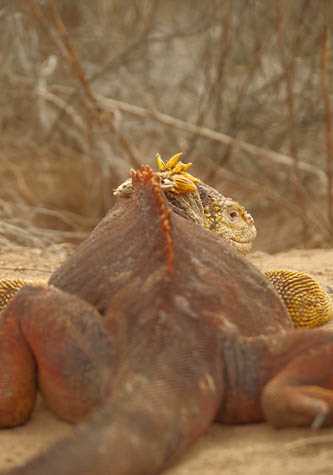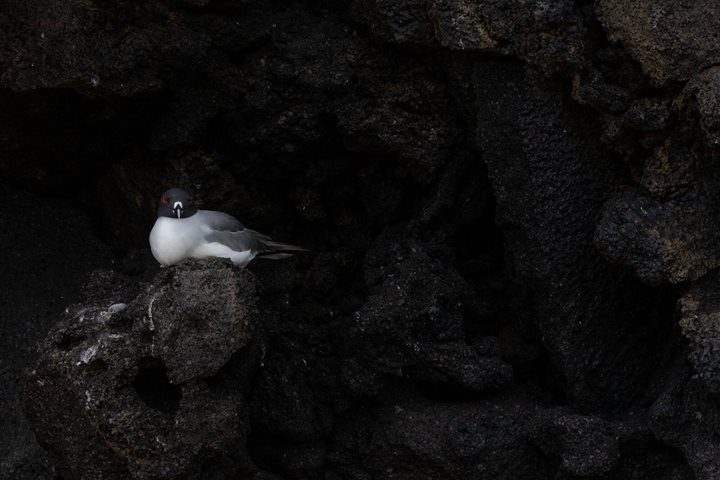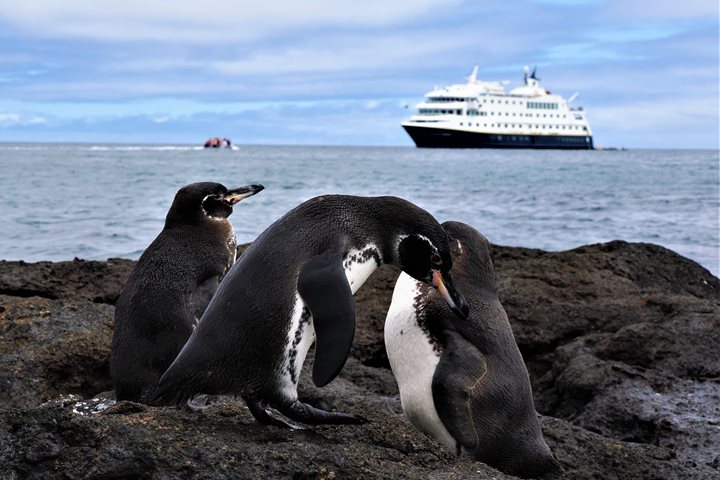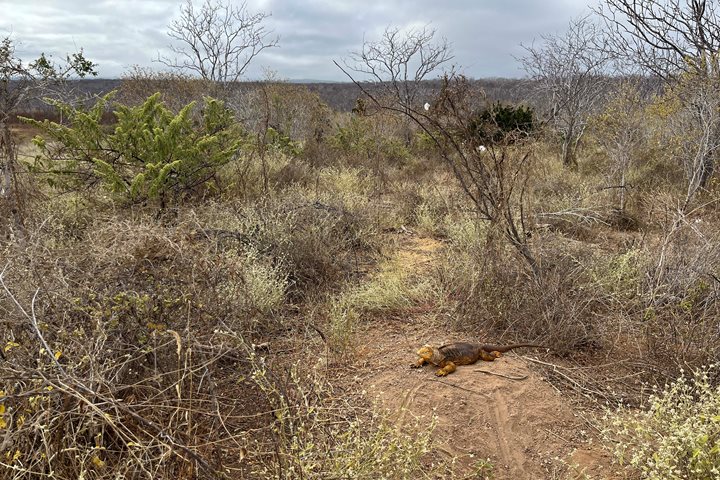Contrast, aperture, light, and storytelling are descriptions for various aspects of photography, however they also are fundamental metaphors for life. This morning in Galapagos, we started our day in each of our individual ways (as we are animals of habit) at Cerro Dragon on Santa Cruz Island. I feel that discovery and exploration have become an integral part of this floating community that has coalesced together, here in the enchanted islands, over the past days. What a contrast of environments, as we head inland with opuntia trees refracting the morning light through their spines, as lush green coastal vegetation lifts us from the coast as we pass a brackish pond. Grey clouds change positions in the sky as we come upon greater flamingos searching for food in the silt of the pond. Transformation of the crustaceans they feed upon into the color we see is an awakening of our senses. As we head inland, we pass the salt resistant green and red vegetation, and we encounter clay like soil that expresses the iron oxide from this volcanically created island. The drastically open aperture states that we are in a rain shadow, and inland is an opera of greys and matted colors. Upon closer inspection, we find the occasional Galapagos bitter bush that tries to burst forward with miniscule dots of color. The occasionally land iguana lumbers about, with an apparent destination but with no schedule. The iguana representing Helios as it moves from east to west on its path, taking the warmth of the sun with it. Palo Santo incense trees with their lichen covered trunks make a connection with the clouds. As we reach the apex of the cerro, we are greeted by a Galapagos flycatcher and its endless search for energy as it continues its lyrical flight. Our altitude gives us a short sense of accomplishment and a wonderful view of the isolated land in the distance. As we continue in our return, we encounter the light of the day trying to illuminate all, although it is muted by the weather of the day. Islands of life are encountered in tidal pools as we return to our landing site. A world in a droplet starts to make sense, as we become empathetic to the incredible struggle for life at every turn. Education and exploration doesn’t cease as we return onboard the National Geographic Endeavour, then head out to the deep blue that surrounds us. Entering the aquatic realm confirms our suspicions, all is connected as a sea lion pup blows bubbles at us and reef fish start to clean us, as if it we should have done this long ago. A story acts as a way to paint a picture, and storytelling is our picture of life. May it continue to express itself.
- Daily Expedition Reports
- 09 Dec 2015
Cerro Dragon – Santa Cruz Island, 12/9/2015, National Geographic Endeavour
- Aboard the National Geographic Endeavour
- Galápagos
Jason Heilmann, Expedition Leader
Growing up in northern California, Jason was surrounded by the incomparable nature of the Pacific Northwest. While attending university there, Jason met and eventually married an Ecuadorian woman who happened to be from a small group of islands off t...
Read MoreShare Report
Galápagos Aboard National Geographic Endeavour II
VIEW ITINERARYRelated Reports
10/6/2022
Read
National Geographic Endeavour II
Bartolome Island & Sombrero Chino
On National Geographic Endeavour II today, we explored Bartolome, home of a small colony of Galapagos penguins. Bartolome is one of the youngest islands, and it is located next to Santiago Island in the central part of the archipelago. After an amazing sunrise, we went ashore for a walk, and we were transported back to a time when the land was newly formed. We began our day by hiking to the top of a tuff cone known as the islet of Bartolome, named after the First Officer of The Beagle . Walking on this young island allowed us to understand the formation and volcanism of the Galapagos Islands. The rocks are a great way to understand the area and its geology. We spotted a few lava lizards and painted locusts, some of the very few animals on this island. As we reached the top, we had a great view. Our guests enjoyed the magnificence of Pinnacle Rock. After we visited one of the most iconic geological formations of the Galapagos, our breakfast was enhanced by dramatic views of the impressive volcanic landscape. We visited the beach near Pinnacle Rock, where we enjoyed how the sun made the sand sparkle due to a concentration of silica. Later, we went snorkeling along the channel between Santiago and Bartolome Islands. Many of our guests spotted whitetip reef sharks and very colorful parrotfish. The landscape was beautiful with lots of sea stars. We enjoyed the chance to be surrounded by Galapagos penguins and feel accepted as part of this environment. After a delicious Mexican lunch, we had lectures on the photography of reptiles and Darwin. Afterwards, we went to Chinese Hat Islet to snorkel from the Zodiacs. The area is home to a small colony of Galapagos penguins. In a sandy-bottomed, sheltered channel, our guests enjoyed swimming with whitetip reef sharks, rays, and many fish. It was a nice and sunny afternoon. After snorkeling, we had the chance to explore the unique, small volcano that formed an island in front of Santiago on a sunset Zodiac ride. After a spectacular day full of activities in the field, we returned on board. Every day in the Galapagos is an opportunity to reconnect with the beauty of nature through unbelievable encounters!
10/5/2022
Read
National Geographic Endeavour II
Cerro Dragón, Santa Cruz Island
Today, National Geographic Endeavour II visited Cerro Dragon, located on the north part of Santa Cruz Island. We found one of the largest colonies of land iguanas. During our hike, we spotted the iguanas all around the trail. Some basked on the vegetation, and others were active. We saw the zigzag head movement they use to protect their territory and impress females. An Ecuadorian buffet lunch was set up in the dining room. We started with the traditional ceviche and ended with tres leches for dessert! We enjoyed snorkeling and Zodiac rides. We observed wildlife all over the place, including spotted eagle rays, sharks, blue-footed boobies, great blue herons, marine iguanas, and hundreds of other animals. They all reminded us why the Galapagos is so special.







